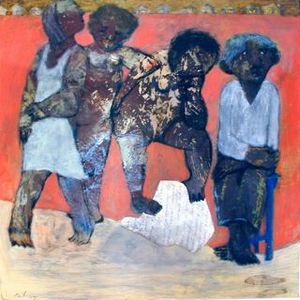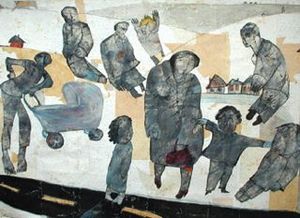Please show your support of Waihekepedia by adding a link to us from your web site. Waihekepedia T Shirts now available at the Ostend Market
Difference between revisions of "Ilya Volykhine"
Jvolykhina (talk | contribs) |
(wrap text around images) |
||
| Line 1: | Line 1: | ||
| + | [[Image:Stories 2005-1.jpg|thumb]] | ||
| + | [[Image:Stories 2005-2.jpg|thumb]] | ||
'''Ilya Volykhine''' (born 1967) is a Russian visual artist. Volykhine was born in Ust Labinsk, Russia, emigrated to the United States in 1991 and lived in New York City. He moved to Australia in late 2000 and has held several solo exhibitions in Australia and his work has been selected for group exhibitions, including the Archibald Prize, Art Gallery of New South Wales (2003) the Blake Prize for Religious Art (2004), Jacaranda Acquisitive Drawing Award Touring Exhibition (2007) and most recently his work was seen in the Walker & Hall Award Exhibition at the [[Waiheke Community Art Gallery]]. He currently has a studio located on Waiheke Island that is open to the public by appointment during the summer season. | '''Ilya Volykhine''' (born 1967) is a Russian visual artist. Volykhine was born in Ust Labinsk, Russia, emigrated to the United States in 1991 and lived in New York City. He moved to Australia in late 2000 and has held several solo exhibitions in Australia and his work has been selected for group exhibitions, including the Archibald Prize, Art Gallery of New South Wales (2003) the Blake Prize for Religious Art (2004), Jacaranda Acquisitive Drawing Award Touring Exhibition (2007) and most recently his work was seen in the Walker & Hall Award Exhibition at the [[Waiheke Community Art Gallery]]. He currently has a studio located on Waiheke Island that is open to the public by appointment during the summer season. | ||
| − | |||
| − | |||
Volykhine uses a combination of oils and paper (archival copies of personal letters from his mother still in Russiain Cyrillic) on panel. The artistʼs versatile use of different expressive media is directly connected to the kaleidoscope of cultures that coexist in his personality: born in the Soviet Union, he has led a mobile existence in Russia, USA and most recently Australia; between the polymorphic vitality of Russian culture and the New York “melting pot” he delves into the idea of the accidental nature of the world as creative force, maintaining a detachment with respect to subjects and materials that allows him to freely explore and express his experience of the world in painting. | Volykhine uses a combination of oils and paper (archival copies of personal letters from his mother still in Russiain Cyrillic) on panel. The artistʼs versatile use of different expressive media is directly connected to the kaleidoscope of cultures that coexist in his personality: born in the Soviet Union, he has led a mobile existence in Russia, USA and most recently Australia; between the polymorphic vitality of Russian culture and the New York “melting pot” he delves into the idea of the accidental nature of the world as creative force, maintaining a detachment with respect to subjects and materials that allows him to freely explore and express his experience of the world in painting. | ||
His works often evoke his own physical presence, his body seen as an instrument through which a relationship of osmosis is established between the creative Self and the rest of the world: the artist is his own body through which, in a constant interplay of inner and outer, physical and psychic, relations are created among different cultures, histories, people and thoughts. They are characterised by luminous vivid colours, or streaky browns set over bright backgrounds and the artistsʼ unique iconography infused with both memories of Russian literature and popular culture. | His works often evoke his own physical presence, his body seen as an instrument through which a relationship of osmosis is established between the creative Self and the rest of the world: the artist is his own body through which, in a constant interplay of inner and outer, physical and psychic, relations are created among different cultures, histories, people and thoughts. They are characterised by luminous vivid colours, or streaky browns set over bright backgrounds and the artistsʼ unique iconography infused with both memories of Russian literature and popular culture. | ||
| − | |||
| − | |||
| − | |||
==External links== | ==External links== | ||
Revision as of 07:26, 11 December 2009
Ilya Volykhine (born 1967) is a Russian visual artist. Volykhine was born in Ust Labinsk, Russia, emigrated to the United States in 1991 and lived in New York City. He moved to Australia in late 2000 and has held several solo exhibitions in Australia and his work has been selected for group exhibitions, including the Archibald Prize, Art Gallery of New South Wales (2003) the Blake Prize for Religious Art (2004), Jacaranda Acquisitive Drawing Award Touring Exhibition (2007) and most recently his work was seen in the Walker & Hall Award Exhibition at the Waiheke Community Art Gallery. He currently has a studio located on Waiheke Island that is open to the public by appointment during the summer season.
Volykhine uses a combination of oils and paper (archival copies of personal letters from his mother still in Russiain Cyrillic) on panel. The artistʼs versatile use of different expressive media is directly connected to the kaleidoscope of cultures that coexist in his personality: born in the Soviet Union, he has led a mobile existence in Russia, USA and most recently Australia; between the polymorphic vitality of Russian culture and the New York “melting pot” he delves into the idea of the accidental nature of the world as creative force, maintaining a detachment with respect to subjects and materials that allows him to freely explore and express his experience of the world in painting.
His works often evoke his own physical presence, his body seen as an instrument through which a relationship of osmosis is established between the creative Self and the rest of the world: the artist is his own body through which, in a constant interplay of inner and outer, physical and psychic, relations are created among different cultures, histories, people and thoughts. They are characterised by luminous vivid colours, or streaky browns set over bright backgrounds and the artistsʼ unique iconography infused with both memories of Russian literature and popular culture.

